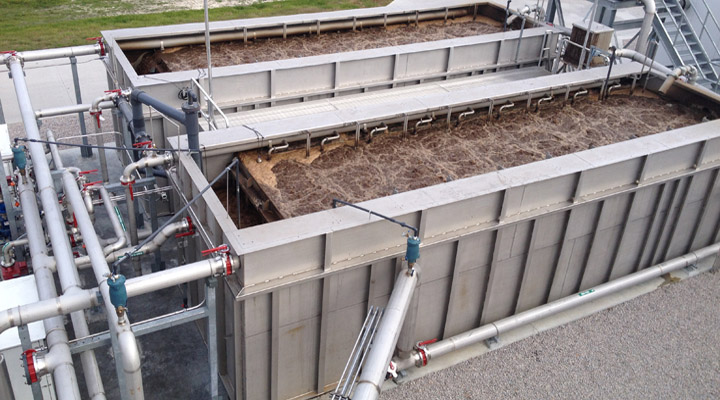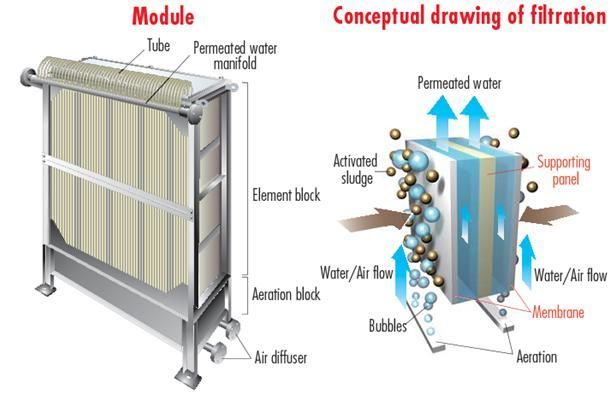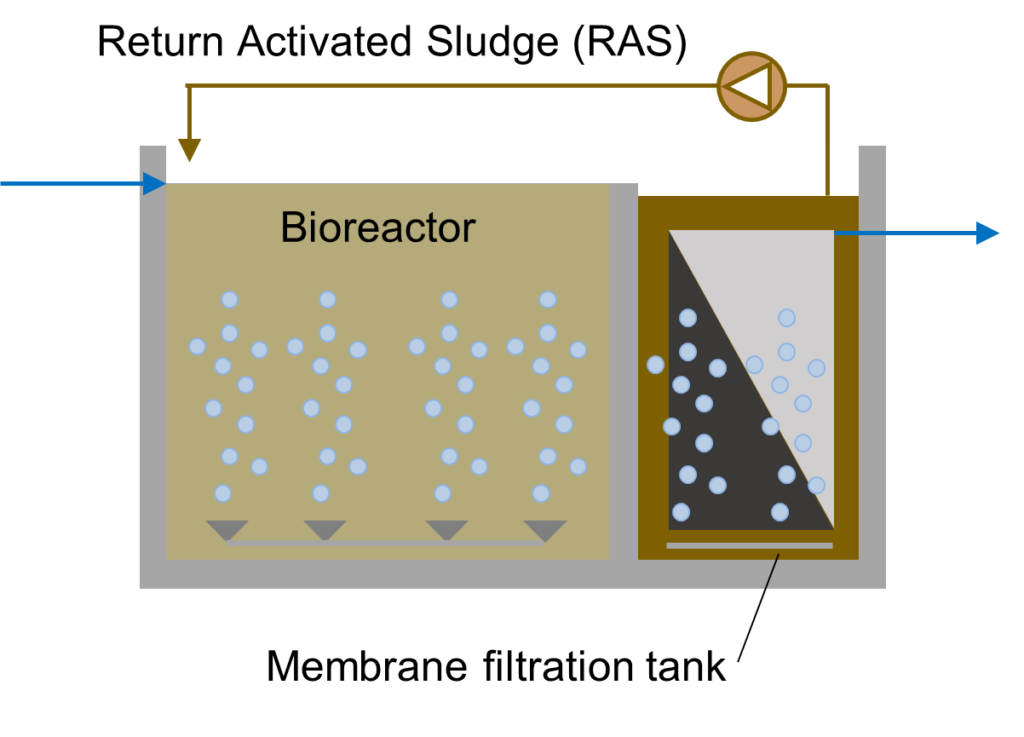How Membrane Bioreactor Contributes to the Reduction of Energy Consumption in Water Treatment
How Membrane Bioreactor Contributes to the Reduction of Energy Consumption in Water Treatment
Blog Article
Membrane Layer Bioreactors Described: Reliable Solutions for Tidy Water
Membrane bioreactors (MBRs) have actually become an advanced service for resolving the pushing challenges of wastewater therapy. By integrating biological processes with sophisticated membrane layer filtration, MBRs not only boost the top quality of cured water but also decrease the spatial requirements of therapy centers. As environmental problems increase, the duty of MBR innovation in advertising lasting water monitoring ends up being significantly substantial. The intricacies of their procedure, advantages, and possible applications warrant a closer examination to completely comprehend their influence on the future of water treatment.

What Are Membrane Bioreactors?
Membrane layer bioreactors (MBRs) are advanced wastewater treatment systems that combine organic destruction procedures with membrane layer filtration modern technology. This assimilation enables the reliable removal of impurities from water, making MBRs a favored selection in different applications, including municipal wastewater therapy and commercial effluent administration.

Among the essential benefits of MBRs is their capability to create premium effluent, typically ideal for reuse in irrigation or commercial procedures. In addition, MBRs call for a smaller impact contrasted to conventional treatment systems, making them ideal for metropolitan settings where room might be limited.
In addition, MBRs can successfully deal with varying influent lots and are much less prone to the effects of toxic shocks. These attributes add to their growing popularity as a lasting remedy for dealing with the boosting need for clean water while reducing environmental impacts.
Exactly How Membrane Bioreactors Work
While the procedure of membrane bioreactors (MBRs) might appear facility, it fundamentally revolves around the harmony between biological procedures and membrane layer filtering. MBRs integrate a biological treatment procedure, typically activated sludge, with a membrane splitting up unit to deal with wastewater successfully.
In an MBR system, wastewater is initial presented into a bioreactor where microbes deteriorate organic issue and other pollutants. The organic activity decreases the focus of pollutants while advertising the growth of biomass. Following this organic therapy, the mixed alcohol goes through membrane purification, which can be microfiltration or ultrafiltration, depending upon the wanted effluent high quality.
The membrane layers serve as a physical barrier, permitting water and little solutes to pass while keeping put on hold solids and bigger molecules. This allows the system to maintain a high concentration of biomass within the reactor, boosting the treatment effectiveness.
Furthermore, the continuous separation of treated water from the biomass helps with a small design and decreases the impact of the treatment facility. Overall, the combination of organic degradation and membrane purification in MBRs leads to effective and reputable wastewater therapy, making certain top quality effluent ideal for numerous applications.
Advantages of MBR Innovation
One of the crucial advantages of membrane bioreactor (MBR) innovation is its capability to create premium effluent with a dramatically reduced footprint contrasted to conventional wastewater treatment methods. MBR systems effectively incorporate organic treatment and membrane layer filtration, causing premium elimination of contaminants, including put on hold solids, microorganisms, and organic issue. This ability leads to effluent that frequently fulfills or goes beyond rigid regulatory standards for reuse and discharge.
Furthermore, MBR modern technology enables greater biomass concentrations, which boosts the treatment efficiency and decreases the called for activator quantity. This compact layout is specifically helpful in metropolitan areas where room is restricted. The operational flexibility of MBR systems additionally suggests they can adjust to varying influent top qualities and circulation rates, making them suitable for a large range of applications.
Moreover, the minimized sludge production associated with MBR procedures contributes to lower operational and maintenance costs. The membrane layers act as a physical obstacle, lessening the danger of clogging and enabling longer functional durations in between cleansing. Overall, the benefits of MBR technology make it an attractive service for lasting wastewater therapy, addressing both ecological concerns and the requirement for efficient resource monitoring.
Applications of Membrane Bioreactors
With their adaptability and effectiveness, membrane bioreactors (MBRs) discover applications across different sectors, consisting of municipal wastewater treatment, industrial processes, and even water improvement. In metropolitan setups, MBRs supply a small service for treating wastewater, effectively removing contaminants while at the same time generating top notch effluent that fulfills strict regulative criteria. This makes them specifically ideal for locations with limited area.
In industrial applications, MBR innovation is made use of for treating procedure water, specifically in markets such as food and beverage, drugs, and petrochemicals. These industries benefit from MBRs' capacity to manage high organic tons and their efficiency in recovering beneficial sources from wastewater, such as nutrients and water.
Furthermore, MBRs play an important duty in water recovery efforts, allowing the check out here reuse of treated wastewater for watering, industrial procedures, and even as safe and clean water after more treatment (Membrane Bioreactor). Their effectiveness in getting rid of toxins his explanation and pathogens makes them a reputable selection for making sure water quality in numerous reuse applications
Future of Water Treatment Solutions
The future of water therapy options is poised for transformative developments driven by technological technology and increasing environmental recognition. As international water scarcity comes to be a pushing concern, new methods, including membrane bioreactor (MBR) systems, are established to play a crucial duty in enhancing the effectiveness and sustainability of water therapy processes.
Emerging innovations such as expert system and artificial intelligence are expected to enhance treatment operations, allowing for real-time tracking and anticipating upkeep. This will enhance the general reliability and effectiveness of water treatment centers. Furthermore, advancements in membrane layer materials, such as graphene and nanofiltration, promise to raise permeation prices and reduce fouling, leading to reduced energy usage and operational costs.
Additionally, the assimilation of renewable resource sources right into water treatment plants will certainly contribute to greener techniques. The round economic climate version will likewise get traction, encouraging the recuperation of beneficial resources from wastewater, such as nutrients and power.
Conclusion

Membrane layer bioreactors (MBRs) have actually emerged as an innovative option for dealing with the pushing click for more info obstacles of wastewater treatment. By integrating biological procedures with sophisticated membrane filtration, MBRs not just improve the quality of cured water yet additionally reduce the spatial needs of therapy centers.One of the essential advantages of membrane layer bioreactor (MBR) innovation is its ability to produce premium effluent with a dramatically decreased impact contrasted to conventional wastewater treatment approaches.With their convenience and effectiveness, membrane layer bioreactors (MBRs) find applications throughout different industries, consisting of local wastewater treatment, industrial processes, and also water reclamation.In verdict, membrane bioreactors represent a substantial improvement in wastewater treatment innovation, incorporating biological processes with efficient membrane layer filtering to generate high-grade effluent.
Report this page